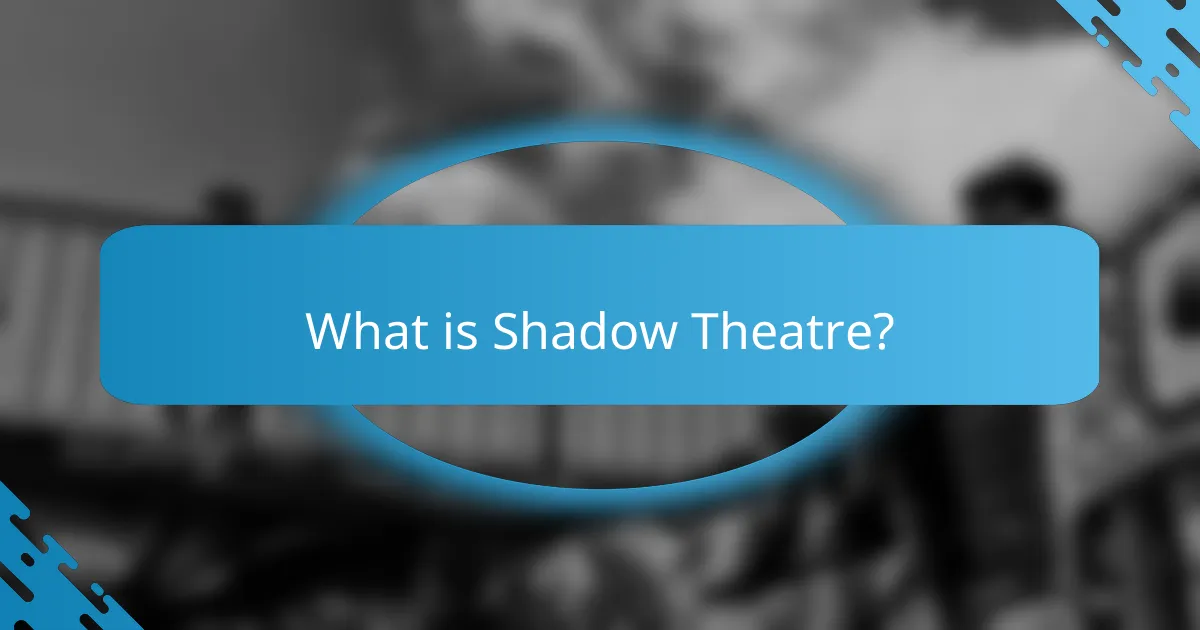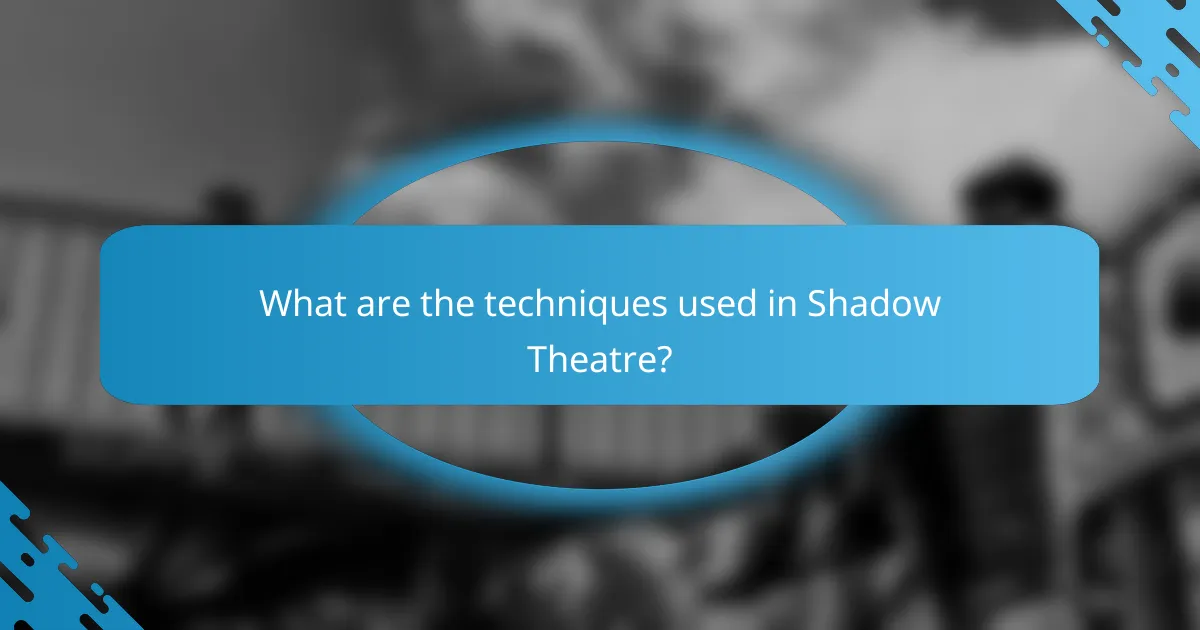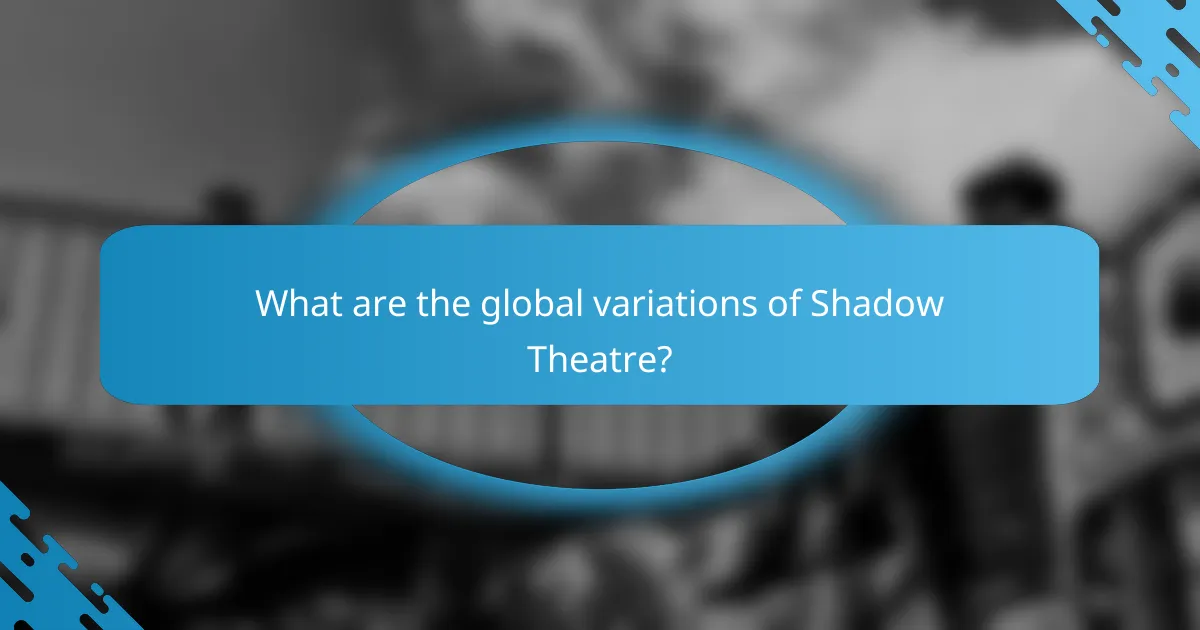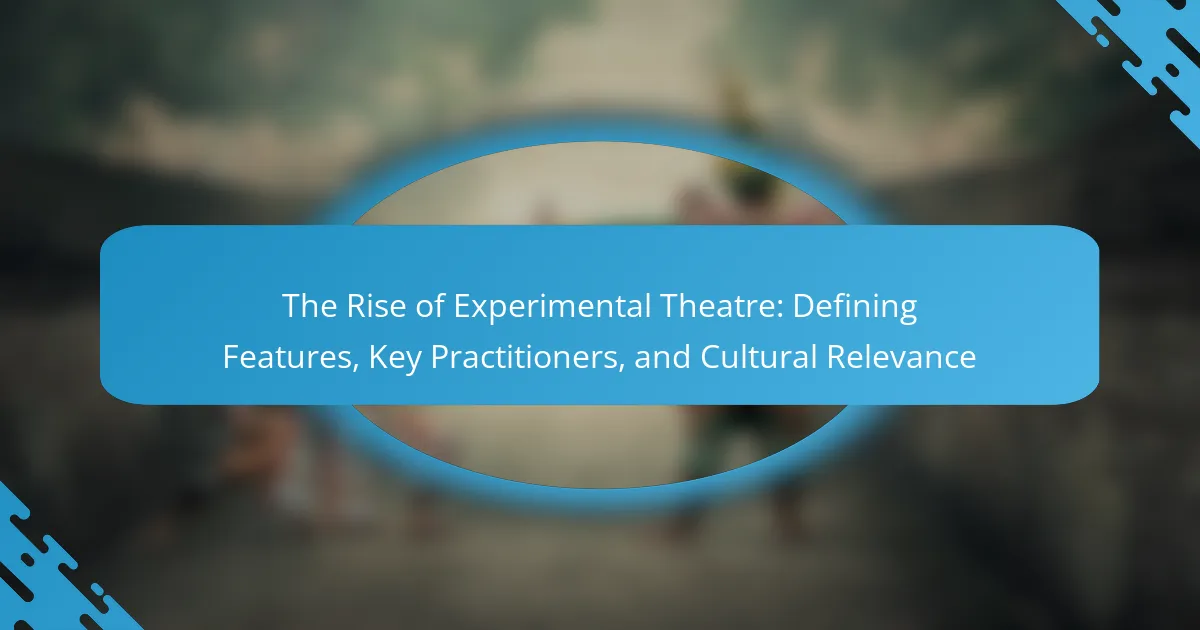Shadow Theatre is a performance art form that utilizes silhouettes to narrate stories through the projection of shadows created by puppets or figures. This article explores the historical context of shadow theatre, tracing its origins in various cultures such as Indonesian Wayang Kulit, Chinese shadow plays, and others. It details the techniques employed in shadow theatre, including the use of cut-out figures, light sources, and sound enhancements to create a compelling visual narrative. Additionally, the article examines the global variations of shadow theatre, highlighting distinct characteristics and cultural narratives reflected in different regions, such as Turkey’s Karagöz and India’s Tholu Bommalata.

What is Shadow Theatre?
Shadow Theatre is a form of performance that uses silhouettes to tell stories. It involves projecting shadows of puppets or figures onto a screen. The performers manipulate these figures behind the screen, creating a visual narrative. This art form has origins in various cultures, including Indonesian Wayang Kulit and Chinese shadow plays. Shadow Theatre engages audiences through its unique visual storytelling technique. It often combines music and narration to enhance the experience. Historical records show that shadow plays date back to ancient civilizations, emphasizing their cultural significance.
How did Shadow Theatre originate?
Shadow Theatre originated in ancient cultures as a form of storytelling and entertainment. It is believed to have begun in China around the Han Dynasty, approximately 200 BCE. Shadow puppetry utilized light and shadow to create visual narratives. This technique spread through trade routes to various regions, including Southeast Asia and the Middle East. In these areas, distinct styles and cultural influences shaped the performances. Historical records indicate that shadow plays were used for both entertainment and religious purposes. The art form evolved, incorporating local myths and legends into its narratives. Today, Shadow Theatre remains a significant cultural expression worldwide.
What are the earliest known examples of Shadow Theatre?
The earliest known examples of Shadow Theatre date back to ancient China and Indonesia. In China, the practice is believed to have originated around the Han Dynasty (206 BCE – 220 CE). Historical texts reference shadow puppetry being used for storytelling and entertainment. In Indonesia, particularly in Java, shadow theatre, known as Wayang Kulit, has roots that trace back to the 9th century. The use of leather puppets to cast shadows on a screen is a hallmark of this tradition. Both cultures utilized shadow theatre for religious and cultural storytelling, solidifying its significance in their respective histories.
How did cultural contexts influence the development of Shadow Theatre?
Cultural contexts significantly influenced the development of Shadow Theatre. Different societies adapted the art form to reflect their unique traditions and beliefs. In Indonesia, for example, Wayang Kulit emerged, showcasing Hindu epics and local folklore. The themes often mirrored societal values and moral lessons. In China, Shadow Theatre evolved alongside storytelling traditions, emphasizing Confucian ideals. Regional materials, such as animal hides and wood, shaped the physical aspects of the puppets. In the Middle East, Shadow Theatre often incorporated Islamic narratives and cultural practices. These adaptations demonstrate how cultural contexts shaped the themes, techniques, and materials used in Shadow Theatre across various regions.
What are the key characteristics of Shadow Theatre?
Shadow Theatre is a form of performance that utilizes silhouettes to tell stories. It involves the use of flat, articulated figures placed between a light source and a screen. The audience sees the shadows cast on the screen, creating an engaging visual experience. The narratives often draw from folklore, mythology, or moral lessons.
Key characteristics include the use of light and shadow to create dramatic effects. The performers manipulate the figures to convey emotions and actions. Traditional music or narration often accompanies the performance, enhancing the storytelling aspect. Shadow Theatre is known for its cultural significance in various regions, such as Indonesia, Turkey, and China. Each culture adds unique elements to the performance style and themes.
What materials and techniques are used in Shadow Theatre productions?
Shadow Theatre productions primarily use materials such as paper, wood, and fabric for creating puppets and screens. These materials are lightweight and allow for intricate designs. Techniques include backlighting, where light is cast from behind the screen to create silhouettes. Manipulation of the puppets is done by rods or strings to bring characters to life. Performers often employ storytelling methods that combine dialogue and visual elements. Historical practices involve using natural light sources, while modern productions utilize electric lighting for enhanced effects. The combination of these materials and techniques creates a captivating visual experience unique to Shadow Theatre.
How does lighting play a role in Shadow Theatre performances?
Lighting is essential in Shadow Theatre performances as it creates the visual effects necessary for storytelling. The positioning and intensity of light determine the clarity and size of the shadows cast. By adjusting lighting angles, performers can manipulate the shapes and movements of the figures. Specific colors of light can evoke different emotions and atmospheres in the narrative. Historical practices show that traditional shadow theatre often used oil lamps or candles to achieve desired effects. Modern techniques incorporate electric lights for greater control and precision. The interplay of light and shadow enhances the audience’s engagement, making the performance more dynamic. This relationship between lighting and shadow is crucial for conveying themes and emotions effectively.

What are the techniques used in Shadow Theatre?
Shadow theatre employs various techniques to create visual storytelling. These techniques include the use of cut-out figures, which are often made from materials like leather or paper. The figures are illuminated from behind, casting shadows on a screen. Manipulation of the figures is done by puppeteers, allowing for dynamic movement.
Light sources can vary, from traditional oil lamps to modern electric lights. The distance between the light source and the screen affects the sharpness of the shadows. Additionally, sound effects and music enhance the storytelling experience.
Some performances incorporate dialogue, while others rely solely on visual elements. The combination of these techniques creates a unique form of theatrical art.
How are puppets created for Shadow Theatre?
Puppets for Shadow Theatre are created through a meticulous process involving design, materials, and construction. Designers first conceptualize the puppet’s shape and features. They often draw sketches to visualize the final product. Common materials include cardboard, wood, or plastic, chosen for their lightness and durability. The puppets are then cut and shaped according to the designs. Artisans paint or decorate the puppets to enhance visual appeal. Finally, they attach rods or strings for manipulation. This process ensures the puppets can cast distinct shadows when illuminated. The effectiveness of Shadow Theatre relies heavily on the quality of these puppets.
What types of materials are commonly used for puppet-making?
Common materials used for puppet-making include wood, fabric, and paper. Wood provides durability and structure for marionettes. Fabric is often used for soft puppets, allowing for flexible designs. Paper is utilized in constructing shadow puppets, as it can create detailed silhouettes. Other materials include foam for lightweight puppets and plastic for more modern designs. These materials are chosen based on the desired puppet type and performance technique. Historical practices often favored natural materials like wood and cloth, reflecting cultural traditions in puppet-making.
How does the design of puppets affect storytelling in Shadow Theatre?
The design of puppets significantly impacts storytelling in Shadow Theatre. Puppets serve as visual representations of characters and themes. Their shapes, colors, and movements convey emotions and narratives effectively. For example, intricate designs can enhance the depth of a character, while simplistic forms may evoke humor or innocence. The material used also influences the light and shadow effects, altering audience perception. Historically, different cultures have employed unique puppet designs to reflect their storytelling traditions. This variety enriches the narrative experience and engages the audience in diverse ways. Research indicates that visual elements in performance art, including puppet design, are crucial for audience connection and comprehension.
What performance techniques are unique to Shadow Theatre?
Shadow Theatre employs unique performance techniques such as silhouette projection and manipulation of light. Silhouette projection involves casting the performers’ shadows onto a screen, creating visual storytelling. This technique allows for dramatic effects and enhances the narrative. Manipulation of light is crucial, as varying light sources change shadow intensity and clarity. Manipulators often use different materials to create distinct shapes and textures. Additionally, puppetry is a common technique, where figures are animated behind the screen. The combination of these techniques creates a captivating and immersive experience. Shadow Theatre’s historical roots, particularly in cultures like Indonesia and Turkey, further emphasize its distinctiveness.
How do performers manipulate shadows to convey narratives?
Performers manipulate shadows to convey narratives by controlling light sources and objects. They position characters or items in front of a light to create silhouettes. The size and shape of shadows can be altered by adjusting the distance from the light source. This technique allows for dramatic effects and emotional depth in storytelling. Additionally, performers may use colored lights to enhance the visual impact. Historical examples include traditional shadow puppetry in Indonesia and Turkey, which illustrate cultural stories. These performances engage audiences through visual representation, making complex narratives accessible.
What role does music and sound play in enhancing Shadow Theatre?
Music and sound play a crucial role in enhancing Shadow Theatre. They create an emotional atmosphere that supports the narrative. Sound effects can heighten tension during dramatic moments. Music can underscore the themes and emotions presented on stage. Together, they engage the audience more deeply. Historical practices show that music has been integral to Shadow Theatre across cultures. For example, traditional Indonesian shadow puppetry often features gamelan music. This combination enriches the storytelling experience and adds layers of meaning.

What are the global variations of Shadow Theatre?
Shadow theatre has various global variations, each with unique characteristics. In Indonesia, Wayang Kulit features intricate leather puppets and traditional music. In Turkey, Karagöz utilizes shadow puppets for comedic storytelling. China’s Shadow Play, known as Piying, often incorporates colorful silk puppets and elaborate performances. In India, Tholu Bommalata uses painted leather puppets and is accompanied by folk music. Greece has the Karaghiozis tradition, which focuses on social satire. Each variation reflects cultural narratives and artistic styles specific to its region. These differences highlight the adaptability of shadow theatre across cultures.
How does Shadow Theatre differ across cultures?
Shadow theatre varies significantly across cultures in terms of style, themes, and techniques. In Indonesia, Wayang Kulit features intricate puppets and often depicts stories from Hindu epics. In contrast, Turkish Karagöz utilizes flat figures and focuses on humor and social commentary. Chinese shadow play, known as Piying, incorporates colorful puppets and emphasizes folklore and historical tales. Each culture also employs distinct performance settings and audience interactions, influencing the overall experience. These differences reflect the unique historical and social contexts of each region, showcasing the adaptability of shadow theatre as an art form.
What are the distinctive features of Indonesian Wayang Kulit?
Indonesian Wayang Kulit is a traditional shadow puppet theatre characterized by several distinctive features. The puppets are made from intricately carved leather, often depicting figures from Hindu epics like the Ramayana and Mahabharata. Performances are accompanied by gamelan music, enhancing the narrative. The puppets are manipulated behind a lit screen, creating shadows that tell stories. The art form incorporates elaborate costumes and vibrant colors in the puppets. Each character has unique attributes, making them easily identifiable. The storytelling often includes moral lessons, reflecting cultural values. Wayang Kulit performances can last several hours, showcasing the complexity of the narratives. This tradition is recognized by UNESCO as a Masterpiece of the Oral and Intangible Heritage of Humanity.
How does Chinese Shadow Theatre compare to its Western counterparts?
Chinese Shadow Theatre features intricate puppetry and storytelling that differs from Western shadow theatre’s simpler forms. The Chinese version often employs colorful, elaborately designed puppets made from leather or cloth. In contrast, Western shadow theatre typically uses flat, black silhouettes. Chinese performances integrate music, dance, and elaborate scripts, emphasizing cultural narratives. Western counterparts often focus on comedic or moralistic themes with less emphasis on cultural storytelling. Historically, Chinese Shadow Theatre dates back over a thousand years, while Western forms emerged in the 18th century. This long tradition contributes to the depth and complexity of Chinese performances. The cultural significance in China is profound, often linked to festivals and rituals. Western shadow theatre, however, is primarily seen as entertainment.
What influences have shaped the evolution of Shadow Theatre worldwide?
Shadow Theatre has evolved worldwide due to cultural exchange, technological advancements, and storytelling traditions. Cultural exchange has introduced various styles and techniques, adapting local narratives. For instance, Indonesian Wayang Kulit influenced shadow puppetry in neighboring regions. Technological advancements, such as the introduction of electric lighting, expanded performance possibilities. Storytelling traditions from different cultures have enriched the themes and characters in shadow theatre. Historical events, including colonization and globalization, also played a role in its dissemination. The fusion of these influences has created diverse forms of shadow theatre globally.
How have modern technologies impacted traditional Shadow Theatre?
Modern technologies have significantly transformed traditional Shadow Theatre. They have introduced advanced lighting techniques, enhancing visual effects. Digital projections now allow for more intricate backgrounds and animations. This integration creates a hybrid form of performance. Additionally, sound technology improves audio quality, enriching the storytelling experience. Social media platforms have expanded audience reach, enabling global sharing of performances. These changes attract younger audiences, revitalizing interest in the art form. Overall, technology has modernized Shadow Theatre while preserving its cultural essence.
What are some contemporary adaptations of Shadow Theatre?
Contemporary adaptations of Shadow Theatre include multimedia performances, interactive installations, and digital storytelling. These adaptations often incorporate modern technology like projection mapping and animation. For example, some artists blend traditional shadow puppetry with live video feeds. This creates a dynamic visual experience. Additionally, contemporary adaptations often address modern themes and social issues. They engage audiences in new ways, making the art form relevant today. Notable examples include the work of companies like Shadowlight Productions, which combine shadows with live music and dance.
What are the best practices for engaging with Shadow Theatre today?
Best practices for engaging with Shadow Theatre today include utilizing modern technology to enhance performances. Integrating digital projections can create dynamic visuals that complement traditional shadow techniques. Collaborating with diverse artists enriches storytelling and expands cultural perspectives. Workshops and community outreach foster audience participation and education. Utilizing social media platforms promotes visibility and connects with broader audiences. Adapting classic narratives to contemporary themes makes the art form more relatable. Regularly updating techniques and materials ensures relevance in a changing artistic landscape. Engaging with local communities strengthens ties and encourages support for the art form.
How can educators incorporate Shadow Theatre into learning experiences?
Educators can incorporate Shadow Theatre into learning experiences by integrating it into various subjects. They can use it to teach storytelling and narrative structure. Shadow Theatre allows students to visualize and express their understanding of themes and characters. It engages students in creative expression through art and performance.
Additionally, educators can facilitate workshops where students create their own shadow puppets. This hands-on activity enhances fine motor skills and encourages teamwork. Incorporating cultural studies, educators can explore the historical significance of Shadow Theatre in different cultures. This approach fosters appreciation for global art forms.
Research shows that incorporating arts in education improves student engagement and retention. For example, a study by the Arts Education Partnership highlights the positive impact of arts integration on learning outcomes.
What resources are available for those interested in exploring Shadow Theatre further?
Books on Shadow Theatre provide foundational knowledge. “The Art of Shadow Theatre” by David L. Smith offers historical insights. Online courses are available through platforms like Coursera and Udemy. These courses cover techniques and cultural significance. Workshops are offered by local theater groups and community centers. They provide hands-on experience in shadow puppetry. Documentaries on platforms like YouTube explore various traditions. The Shadow Theatre Association’s website lists resources and events. Academic journals publish research articles on shadow theatre practices.
Shadow Theatre is a performance art that utilizes silhouettes to narrate stories through the projection of shadows from puppets or figures onto a screen. This article explores the historical origins of Shadow Theatre, tracing its roots back to ancient cultures such as China and Indonesia, and highlights its cultural significance and evolution over time. Key characteristics, materials, and techniques used in Shadow Theatre are examined, alongside the influence of cultural contexts on its development. Additionally, the article discusses global variations, modern adaptations, and best practices for engaging with this art form today.



